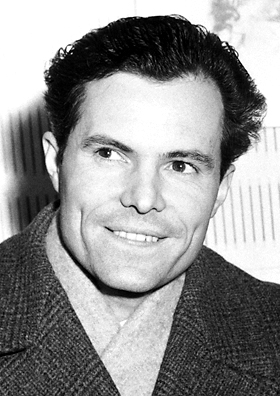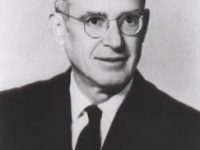
Rudolf Mössbauer (1929-2011)
On January 31, 1929, German physicist and Nobel Laureate Rudolf Ludwig Mössbauer was born. He is best known for his 1957 discovery of recoilless nuclear resonance fluorescence for which he was awarded the 1961 Nobel Prize in Physics. This effect, called the Mössbauer effect, is the basis for Mössbauer spectroscopy.
“Explain it! The most important thing is, that you are able to explain it! You will have exams, there you have to explain it. Eventually, you pass them, you get your diploma and you think, that’s it! – No, the whole life is an exam, you’ll have to write applications, you’ll have to discuss with peers… So learn to explain it! You can train this by explaining to another student, a colleague. If they are not available, explain it to your mother – or to your cat!”
– Rudolf Mössbauer, [11]
Rudolf Mössbauer – Early Life
Rudolf Mössbauer was born in Munich, the only son of Ludwig Mössbauer, a phototechnician who printed color post cards and reproduced photographic materials, and his wife Erna. He was educated at the Oberschule in Munich-Pasing and left after matriculating in 1948. His plans to attend a university were thwarted because, due to Germany’s loss in the war, the number of new enrollments was greatly reduced.[2] After working for one year as an optical assistant first at the Rodenstock optical firm in Münich due to the efforts of his father, and later for the U.S. Army of Occupation, Mössbauer started to study physics at the Technical University in Munich in 1949, where he passed his preliminary diploma degree examinations (the equivalent of a B.S. degree) in 1952.
He prepared his Diploma thesis in the Laboratory of Applied Physics of Heinz Maier-Leibnitz, a physicist with a special interest in the field of nuclear resonance fluorescence. At the same time he was acting as assistant lecturer at its Institute of Mathematics, and graduated in 1955. He then went to the Max Planck Institute for Medical Research in Heidelberg, in the course of which he carried out the first experimental observation of the phenomenon of Recoilless Nuclear Resonance Absorption. Since this institute, not being part of a university, had no right to award a doctorate, Mössbauer remained under the auspices of Maier-Leibnitz, who then was his official thesis supervisor when he passed his PhD exam in Munich in 1958 with a thesis on Kernresonanz-Fluoreszenz von Gammastrahlen im Iridium 191 (Nuclear resonance fluorescence of gamma rays in iridium 191).
Nuclear Resonance Flourescence
Nuclear resonance fluorescence is is comparable to widely-known phenomena such as, for example, the resonance in tuning forks. When one tuning fork is struck, it begins to vibrate with a certain frequency. When a second tuning fork is struck close to the first, it begins vibrating with the same frequency, and is said to be “resonating” with the first tuning fork. Fluorescence now is a form of resonance involving visible light and when light hits specific materials, the atoms that make up those materials may absorb electromagnetic energy and then re-emit it. The emitted energy has the same frequency as the original light as a result of the resonance within atoms of the material. [2] Probably you might know this effect from special materials that glow in the dark after having been exposed to light.
Absorption and Recoil
From the year 1953 onwards his main work was directed towards the study of absorption of gamma rays in matter, in particular the study of nuclear resonance absorption.[1] In his PhD work, Mössbauer discovered recoilless nuclear fluorescence of gamma rays in 191 iridium, a radioactive isotope of a platinum-like metal, from then on known as the Mössbauer effect. He discovered that at low temperatures a gamma emitter could be fixed within the crystal lattice of a material in such a way that it produced no recoil when it released a gamma ray. Instead, the recoil energy was absorbed by and distributed throughout the total crystal lattice in which the emitter was imbedded. The huge size of the crystal compared to the minute size of the emitter atom essentially “washed out” any recoil effect.[2]
The Mössbauer Effect
The initial reactions to the Mössbauer papers on gamma ray emission ranged from disinterest to doubt. According to one widely-repeated story, two physicists at the Los Alamos Scientific Laboratory made a five-cent bet on whether or not the Mössbauer Effect really existed. When one scientist was in fact able to demonstrate the effect, the scientific community gained interest.[2] Mössbauer’s fame grew immensely in 1960 when Harvard physicists Robert Pound and Glen Rebka used this effect to prove the red shift of gamma radiation in the gravitational field of the Earth. This Pound–Rebka experiment was one of the first experimental precision tests of Albert Einstein‘s general theory of relativity. In his 1905 theory, Einstein had predicted that photons are affected by a gravitational field, and therefore an electromagnetic wave should experience a change in frequency as it passes near a massive body. Astronomical tests had been previously devised to check this prediction, but these tests tended to be difficult in procedure and imprecise in their results.[2,5] The long-term importance of the Mössbauer effect, however, is its use in Mössbauer spectroscopy. Along with Robert Hofstadter, Rudolf Mössbauer was awarded the 1961 Nobel Prize in Physics [6].
Later Life
On the suggestion of Richard Feynman [4], Mössbauer was invited in 1960 to Caltech, where he advanced rapidly from Research Fellow to Senior Research Fellow. He was appointed a full professor of physics in early 1962. In 1964, his alma mater, the Technical University of Munich (TUM), convinced him to go back as a full professor. He retained this position until he retired as professor emeritus in 1997. As a condition for his return, the faculty of physics introduced a “department” system. This system, strongly influenced by Mössbauer’s American experience, was in radical contrast to the traditional, hierarchical “faculty” system of German universities, and it gave the TUM an eminent position in German physics. Mößbauer advocated international cooperation in physics, especially with Soviet scientists, even during the Cold War. He visited the Soviet Union several times and organized meetings of American and Soviet physicists.
In 1972, Rudolf Mössbauer went to Grenoble to succeed Heinz Maier-Leibnitz as the director of the Institut Laue-Langevin just when its newly built high-flux research reactor went into operation. After serving a 5-year term, Mössbauer returned to Munich, where he found his institutional reforms reversed by overarching legislation. Until the end of his career, he often expressed bitterness over this “destruction of the department.”
Rudolf Mössbauer died on 14 September 2011 at age 82.
(7) Eckhard Bill, „Mössbauer Spectroscopy“, [11]
References and Further Reading:
- [1] Rudolf Mössbauer biography at Nobelprize.org
- [2] “Rudolf Mössbauer.” Encyclopedia of World Biography. 2004. Encyclopedia.com.
- [3] Rudolf Ludwig Mössbauer, German physicist, at Britannica Online
- [4] Surely You’re Joking, Mr. Feynman, SciHi blog, May 12, 2012.
- [5] Albert Einstein revolutionized Physics, SciHi Blog, March 14, 2013.
- [6] Robert Hofstadter and controlled Nuclear Fission, SciHi Blog, February 5, 2016.
- [7] Dieter Hoffmann, Günter Kaindl: Physiker und Pianist. Nachruf (Obituary), in German, Tagesspiegel. 20. September 2011
- [8] Rudolf Mössbauer at Wikidata
- [9] Rudolf Mössbauer at Reasonator
- [9] Timeline for Rudolf Mössbauer via Wikidata
- [10] Literature by and about Rudolf Mössbauer in the German National Library catalogue
- [11] (7) Eckhard Bill, „Mössbauer Spectroscopy“, 2016, Max Planck Society Lectures @ youtube
- [12] Rudolf Mössbauer at English Wikipedia, retrieved at 31.01.2020






Pingback: Whewell’s Gazette: Year 2, Vol. #30 | Whewell's Ghost